Collection / Russian
Painting
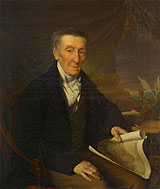 A small collection of icons of the sixteenth-seventeenth centuries brings the viewer closer to the roots of national traditions, making more notable the importance of the change towards secular culture at the turn of eighteenth century, mainly expressed in portrait painting.The refined female images of Feodor Rokotov (1730-1808), the ceremonial portraits by Dmitry Levitsky (1735-1822), the psychologically and emotionally coloured works of Vladimir Borovikovsky (1754-1825), and the masterly paintings of the foreigners Louis Tocque (1696-1772), Vigilius Eriksen (1722-1782), and Pietro Rotari (1707-1762) altogether form a “multi-faced” artistic world united by the ideals and notions about human personality closely connected with the model`s social status.They witness to the arising interest towards human individuality and inner life.
A small collection of icons of the sixteenth-seventeenth centuries brings the viewer closer to the roots of national traditions, making more notable the importance of the change towards secular culture at the turn of eighteenth century, mainly expressed in portrait painting.The refined female images of Feodor Rokotov (1730-1808), the ceremonial portraits by Dmitry Levitsky (1735-1822), the psychologically and emotionally coloured works of Vladimir Borovikovsky (1754-1825), and the masterly paintings of the foreigners Louis Tocque (1696-1772), Vigilius Eriksen (1722-1782), and Pietro Rotari (1707-1762) altogether form a “multi-faced” artistic world united by the ideals and notions about human personality closely connected with the model`s social status.They witness to the arising interest towards human individuality and inner life.
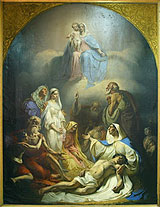 The ninetheenth century is exhibited in the Museum more diversely, with a wider range of genres, stylistic trends and artistic individualities.Classicism and Romanticism, the main trends of the first half of the nineteenth century,are represented by the portraits of Dmitry Filosofov (1872-1940) by Orest Kiprensky (1782-1836), of P. Kamensky and M. Bek by Karl Brullov (1799-1852), and other works of the Museum`s collection. Under the influence of the tendencies of their time, they created a new world of images, lofty and noble, full of refined emotions.The works of the most popular painters such as Karl Brullov (1799-1852), strongly influenced the painters of the academic style, namely Pyotr Basin (1793), Pimen Orlov (1818-1863), Ivan Khrutsky (1810-1885), Vladimir Sverchkov (1821-1888) et al. The striving for more vivid and realistic approach to depicting characters is typical of Alexey Venetsianov (1780-1847) and Vasily Tropinin (1776-1857); besides scenes of everyday-life, they painted a series of expressive portraits of their contemporaries. The portraits of the Lazarevs painted by Tropinin are not only of artistic, but also of historical interest. Being one of the well-to-do families in Russia, the Lazarevs are famous for their beneficial activity. Thanks of the financial support of the family in 1815 the Institute of Oriental Languages was founded in Moscow, where translators for the Caucasus were trained, and also indigent Armenians could get free education.
The ninetheenth century is exhibited in the Museum more diversely, with a wider range of genres, stylistic trends and artistic individualities.Classicism and Romanticism, the main trends of the first half of the nineteenth century,are represented by the portraits of Dmitry Filosofov (1872-1940) by Orest Kiprensky (1782-1836), of P. Kamensky and M. Bek by Karl Brullov (1799-1852), and other works of the Museum`s collection. Under the influence of the tendencies of their time, they created a new world of images, lofty and noble, full of refined emotions.The works of the most popular painters such as Karl Brullov (1799-1852), strongly influenced the painters of the academic style, namely Pyotr Basin (1793), Pimen Orlov (1818-1863), Ivan Khrutsky (1810-1885), Vladimir Sverchkov (1821-1888) et al. The striving for more vivid and realistic approach to depicting characters is typical of Alexey Venetsianov (1780-1847) and Vasily Tropinin (1776-1857); besides scenes of everyday-life, they painted a series of expressive portraits of their contemporaries. The portraits of the Lazarevs painted by Tropinin are not only of artistic, but also of historical interest. Being one of the well-to-do families in Russia, the Lazarevs are famous for their beneficial activity. Thanks of the financial support of the family in 1815 the Institute of Oriental Languages was founded in Moscow, where translators for the Caucasus were trained, and also indigent Armenians could get free education.
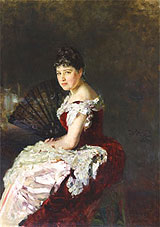 The Lazarevs who were in close relationship with progressive circles of Russian intellectuals, served as models for portraits by the outstanding Russian masters Ivan Argunov (1723-1802), Vasily Tropinin (1776-1857), Sergey Zaryanko (1818-1870) et al. Their works are kept in the Museum. Tropinin’s “Portrait of H. A. Lazarev” (1822) is one of his best works painted in the traditional manner of ceremonial portrait buy coloured with sincerity and cordiality characteristic of the author, and thus endowed with mood of intimacy.
The Lazarevs who were in close relationship with progressive circles of Russian intellectuals, served as models for portraits by the outstanding Russian masters Ivan Argunov (1723-1802), Vasily Tropinin (1776-1857), Sergey Zaryanko (1818-1870) et al. Their works are kept in the Museum. Tropinin’s “Portrait of H. A. Lazarev” (1822) is one of his best works painted in the traditional manner of ceremonial portrait buy coloured with sincerity and cordiality characteristic of the author, and thus endowed with mood of intimacy.
Tha realistic achievements of the authors of genre painting intensely developed in the second half of the nineteenth century, in the works of the Peredvizhniks, being most vividly expressed in the pictures by the outstanding representatives of that trend Ilya Repin (1844-1930) and Vasily Surikov (1848-1916). Their works in the collection of the Museum illustrate the innovating achievements of the masters of historical and portrait painting. “The Barge Hauler” (1870-1873), “The portrait of M. Klimentova”, “The Blonde Woman”, “The potriat of Solsky” (1903), and “A Duel” are testimonies to Repin’s extraordinary talent, his ability to find artistic forms corresponding to the model, and of his free and wide manner of painting endowing his characters with expressiveness.
The reestablishment of the genre of landscape, is also connected with the names of the Peredvizhniks. The portrayal of the native land, dependent on the talent of each master, created a variety and richness of landscape images.The exposition allows one to trace the development of the genre during the nineteenth-twentieth centuries. Elements of lyricism are characteristic of the painters of the first half of the nineteenth century, especially in the works of Silvestr Shchedrin (1791-1830) and Mikhail Lebedev (1811-1837). This was further developed in the works of later masters, namely in the emotive works by the founder of national landscape painting, Alexey Savrasov (1830-1897), sketches by Fjodor Vasiliev (1850-1873) and the light and airy works of Vasili Polenov (1844-1927). Adding to this development were the musical landscapes of Isaak Levitan (1860-1900), Valentin Serov’s (1865-1911) generalized compositions, and Konstantin Korovin’s (1861-1939) impressionistic landscapes.
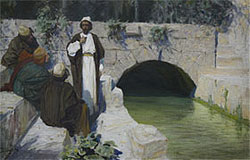 Another kind of realistic landscape is represented by the works of Ivan Shishkin (1832-1898) and Archip Kuindshi (1841/42-1910). Characterized by monumental tendencies, and a large scale of interpretation of images, these works are typical of the epic compositions kept in the Gallery.
Another kind of realistic landscape is represented by the works of Ivan Shishkin (1832-1898) and Archip Kuindshi (1841/42-1910). Characterized by monumental tendencies, and a large scale of interpretation of images, these works are typical of the epic compositions kept in the Gallery.
The exposition of the works of the masters of the late nineteenth and early twentieth centuries is the most comprehensive and contains many masterpieces. Valentin Serov (1865-1911) himself had mentioned that portrait of M. Akimova was among his five best portraits. This work impresses the viewer with extraordinary boldness of image-bearing devices and beauty of colour . Its colouring built the combination of rich, lush red and blue coloures and refined white, black and golden tones, stresses the delicacy and subtle charm of the model’s Eastern beauty.
Theatrical designs are only a part of the exposition of various works by the members of the artistic circle “Mir iskusstva” (“World of Art”). These works include sceneries and compositions of Alexander Benois (1870-1960) and Alexander Golovin (1863-1930), works by Konstantin Somov (1869-1939) reviving the spirit of epochs, the self-portrait by Zinaida Serebryakova (1906-1991), and the Petersburg motifs by Anna Ostroumova-Lebedeva (1871-1955) and Nikolai Roerich’s (1874-1947).The inclination for the synthesis of arts, and vivid interest 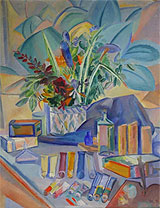 towards the historical heritage are the characteristic features of their works. The journal bearing the same name “Mir Iskusstva” united the best artists of Russia and predetermined many of the main trends of the epoch. This group included the most brilliant Russian impressionist Konstantin Korovin (1861-1939), symbolist Mikhail Vrubel (1856-1910), the future members of the association “Golubaya Roza” (The Blue Rose) Nikolai Sapunov (1880-1912), and Sergei Sudeikin (1882-1946). Along with the above mentioned artists Pavel Kuznetsov (1878-1965), Petr Utkin (1877-1934), Martiros Sarian (1880-1972) and Kuzma Petrov-Vodkin (1878-1939), developed the artistic principles of one of the most important trends in Russian painting, Symbolism.The younger generation of Symbolists, despite the variety of artistic abilities and the nature of their talent, was united by the expression of personal feelings, and the emotions of the soul. They strove to penetrate beyond the border of the visible, and in doing so managed to enrich symbolism by creating a new structure of painted images.
towards the historical heritage are the characteristic features of their works. The journal bearing the same name “Mir Iskusstva” united the best artists of Russia and predetermined many of the main trends of the epoch. This group included the most brilliant Russian impressionist Konstantin Korovin (1861-1939), symbolist Mikhail Vrubel (1856-1910), the future members of the association “Golubaya Roza” (The Blue Rose) Nikolai Sapunov (1880-1912), and Sergei Sudeikin (1882-1946). Along with the above mentioned artists Pavel Kuznetsov (1878-1965), Petr Utkin (1877-1934), Martiros Sarian (1880-1972) and Kuzma Petrov-Vodkin (1878-1939), developed the artistic principles of one of the most important trends in Russian painting, Symbolism.The younger generation of Symbolists, despite the variety of artistic abilities and the nature of their talent, was united by the expression of personal feelings, and the emotions of the soul. They strove to penetrate beyond the border of the visible, and in doing so managed to enrich symbolism by creating a new structure of painted images.
Having exhausted itself by 1910, Symbolism nevertheless greatly influenced the first steps of the painters of Russian avant-garde. This movement united masters of various orientations, including Natalia Goncharova (1881-1962), Mikhail Larionov (1881-1964), Pavel Filonov (1883-1941), Vasili Kandinsky (1866-1944) and Marc Chagall (1887-1985), closely related to Russian culture, and the members of the circle “Bubnovy valet” (“The Knave of Diamonds”) Piotr Konchalovsky (1876-1956), Alexander Kuprin (1880-1960) and Robert Falk (1886-1958). They integrated in their works the traditions of national painting, primitive art, urban folk art, icon painting, and the achievements of Western European art including post-Impressionism, Cubism, and other trends.
The Gallery possesses works by famous painters of the avant-garde, and permanent participants of international exhibitions, which today determine the 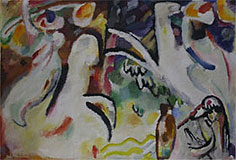 popularity of the collection. Vasili Kandinsky’s (1866-1944) “The Oriental suite; Arabs ׀׀׀” is one of the masterpieces of the collection.It was painted in 1911, at a crucial moment in Kandinsky’s work, and is characterized by the appearance of new, abstract forms.The composition is dynamic due to correlation of lines, forms and spots, which transform silhouettes of flying riders, into the jar and contours of a woman’s figure. Although they are signs and symbols traditionally connected with the East, all these images are easy to recognize. The contrast of warm and cool colours establishes the mood of the work and while the original colouristic harmony expresses the spirit and atmosphere of the East.
popularity of the collection. Vasili Kandinsky’s (1866-1944) “The Oriental suite; Arabs ׀׀׀” is one of the masterpieces of the collection.It was painted in 1911, at a crucial moment in Kandinsky’s work, and is characterized by the appearance of new, abstract forms.The composition is dynamic due to correlation of lines, forms and spots, which transform silhouettes of flying riders, into the jar and contours of a woman’s figure. Although they are signs and symbols traditionally connected with the East, all these images are easy to recognize. The contrast of warm and cool colours establishes the mood of the work and while the original colouristic harmony expresses the spirit and atmosphere of the East.
Another masterpiece of the collection is Marc Chagall’s (1887-1985) “Summer House” painted in 1917, in one of the happy periods of his life, the composition attracts the viewer with sincerity and poetic spirit characteristic of the master. 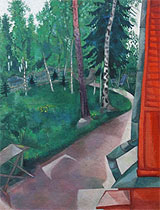
The works by the followers of P. Sezanne (the painters of the circle “Bubnovy valet”) Ilya Mashkov (1881-1944), and Alexander Kuprin (1880-1960), alongside with their associates Mikhail Larionov (1881-1964), Natalia Goncharova (1881-1962), are the pride of the Russian collection. More than seventeen works by Robert Falk (1886-1958) are kept in the Museum. These works are among his masterpieces and are evidence to his high artistic skill and rare sense of colour. Those features are wonderfully expressed in one of his best works, “A Woman in a Rose Shawl”, the portrait of the painter’s wife, A. Shchekin-Krotova. The colouring worked up in rose and grey tones stresses the refinement and femininity of the model, endowing her image with special spirituality and lyricism.
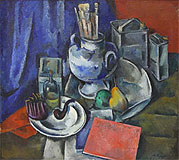 The exposition of the Museum also represents works by masters of the Soviet school. Although the exhibits are not numerous, they cover the important stages of that period. The Gallery possesses works by the leading Soviet painters Piotr Konchalovsky (1876-1956), Arkadi Plastov (1893-1972), Pavel Korin (1892-1967), Sergei Gerassimov (1885-1964), Alexandr Deineka, Tatyana Yablonskaya (1917-2005). The collection also includes works by the painters of the “severe style” Anatoli Nikich (1918), Viktor Popkov (1932-1974) and other modern authors: Alexander Sukhanov (1945), Natalia Nesterova (1944), Yuri Zharkikh (1938) and Pavel Kondratev (1902-1985). Those works reveal the artistic strivings of the mentioned masters and the world outlook of whole epoch.
The exposition of the Museum also represents works by masters of the Soviet school. Although the exhibits are not numerous, they cover the important stages of that period. The Gallery possesses works by the leading Soviet painters Piotr Konchalovsky (1876-1956), Arkadi Plastov (1893-1972), Pavel Korin (1892-1967), Sergei Gerassimov (1885-1964), Alexandr Deineka, Tatyana Yablonskaya (1917-2005). The collection also includes works by the painters of the “severe style” Anatoli Nikich (1918), Viktor Popkov (1932-1974) and other modern authors: Alexander Sukhanov (1945), Natalia Nesterova (1944), Yuri Zharkikh (1938) and Pavel Kondratev (1902-1985). Those works reveal the artistic strivings of the mentioned masters and the world outlook of whole epoch.